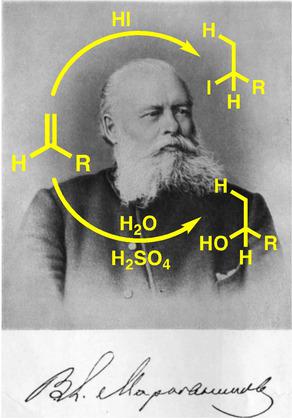当前位置:
X-MOL 学术
›
Angew. Chem. Int. Ed.
›
论文详情
Our official English website, www.x-mol.net, welcomes your feedback! (Note: you will need to create a separate account there.)
The Logic Behind Markovnikov's Rule: Was It an Inspired Guess? …No!
Angewandte Chemie International Edition ( IF 16.6 ) Pub Date : 2020-12-08 , DOI: 10.1002/anie.202008228 David E. Lewis 1
Angewandte Chemie International Edition ( IF 16.6 ) Pub Date : 2020-12-08 , DOI: 10.1002/anie.202008228 David E. Lewis 1
Affiliation

|
Vladimir Vasil′evich Markovnikov (1837–1904) was a Russian chemist whose graduate research at Kazan Imperial University from 1860–1869 gave us, among other things, one of the most enduring empirical rules in organic chemistry. Markovnikov's Rule for electrophilic addition was first published in the inaugural volume of the Journal of the Russian Chemical Society (Zh. Russ. Khim. O‐va.), but it was not until a year later when it was published in German that it received attention internationally. The rule itself was worded differently from the most common modern versions, in that it is expressed in terms of the electronegative part of the adding reagent. It has been suggested that this rule was the result of an inspired guess, but a careful examination of Markovnikov's graduate dissertations reveals a very different picture. In the dissertations, there is a careful build‐up of logic from which the rule itself, as defined by Markovnikov, emerges naturally. Markovnikov's Rule was most decidedly not an inspired guess.
中文翻译:

马尔可夫尼科夫定律背后的逻辑:这是一个启发性的猜测吗?…不!
弗拉基米尔·瓦西尔·埃维奇·马尔科夫尼科夫(Vladimir Vasil'evich Markovnikov,1837–1904年)是俄罗斯化学家,他从1860年至1869年在喀山帝国大学的研究生研究为我们提供了有机化学中最持久的经验规则之一。马尔可夫尼科夫的亲电加成法则首先发表在《俄罗斯化学学会杂志》(Zh。Russ。Khim。O-va),但直到一年后以德语出版时,它才受到国际关注。该规则本身的措词与最常见的现代版本有所不同,因为它以添加试剂的负电性部分表示。有人认为,这条规则是一个有启发性的猜测的结果,但是仔细检查一下马尔科夫尼科夫的毕业论文却发现了截然不同的情况。在论文中,仔细地建立了逻辑,马尔科夫尼科夫所定义的规则本身就自然而然地出现了。马尔科夫尼科夫定律绝对不是一个有根据的猜测。
更新日期:2021-02-16
中文翻译:

马尔可夫尼科夫定律背后的逻辑:这是一个启发性的猜测吗?…不!
弗拉基米尔·瓦西尔·埃维奇·马尔科夫尼科夫(Vladimir Vasil'evich Markovnikov,1837–1904年)是俄罗斯化学家,他从1860年至1869年在喀山帝国大学的研究生研究为我们提供了有机化学中最持久的经验规则之一。马尔可夫尼科夫的亲电加成法则首先发表在《俄罗斯化学学会杂志》(Zh。Russ。Khim。O-va),但直到一年后以德语出版时,它才受到国际关注。该规则本身的措词与最常见的现代版本有所不同,因为它以添加试剂的负电性部分表示。有人认为,这条规则是一个有启发性的猜测的结果,但是仔细检查一下马尔科夫尼科夫的毕业论文却发现了截然不同的情况。在论文中,仔细地建立了逻辑,马尔科夫尼科夫所定义的规则本身就自然而然地出现了。马尔科夫尼科夫定律绝对不是一个有根据的猜测。

































 京公网安备 11010802027423号
京公网安备 11010802027423号